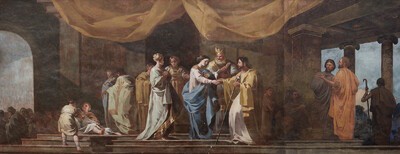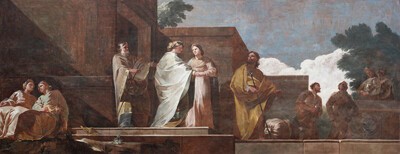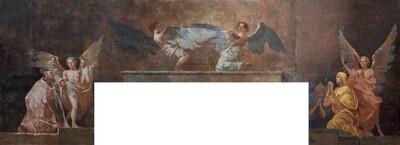- Cronología
- Ca. 1774
- Ubicación
- Church of the Monastery of Aula Dei, Zaragoza, Spain
- Dimensiones
- 306 x 1.025 cm
- Técnica y soporte
- Oil on plaster
- Reconocimiento de la autoría de Goya
- Documented work
- Titular
- Instituto Chemin Neuf
- Ficha: realización/revisión
- 07 Oct 2010 / 13 Jun 2023
- Otros títulos:
-
The Adoration of the Magi (La adoración de los Reyes Magos)
Along with Circumcision of Christ (La circuncisión), this painting at 10 metres in length is one of the scenes that occupies the most space of the set. It is also located in one of the arms of the transept - in this case on the Evangelical side - and is painted on the three walls in the form of a triptych.
A good part of the original painting by Goya was lost from the left-hand panel and was repainted by the Buffet brothers.
In this case the Holy Family are not placed at the centre of the composition but on the right-hand side, while the central figure is Gaspar: bearded, crowned and wearing a vast white cloak, he stands out clearly against the background of blue-grey clouds and sky, the Star of Bethlehem shining over on the right. Behind Gaspar, a woman wearing a veil carries a box of offerings in her hands. At the feet of the king we can see the heads of two camels expressed in whitish hues.
Melchior is pictured on the right in the foreground, wearing a bright yellow cloak and kneeling before the Virgin to worship the Christ Child who she bears in her arms. These three figures and Saint Joseph, placed behind the King, are placed before the ruins of a classical style building with pilasters and columns. Behind Melchior, Balthazar stands watch in a red and gold tunic.
Apart from the figures painted by the Buffet brothers, the group on the left is populated by very poorly defined figures, almost mere sketches in the shadows, who contemplate the scene of the Epiphany with awe and reverence.
See Revelation to Saint Joachim and Saint Anne for a history of the complete set of works housed in this church.
Restauradas por Carlos Barboza y Teresa Grasa entre 1978 y 1979.
Restaurada por el Gobierno de Aragón entre 2009 y 2011: se hizo un estudio del estado de conservación, limpieza, consolidación, eliminación de sales, análisis y estudios ambientales, eliminación de elementos nocivos para la película pictórica, saneamiento y restauración de grietas, restauración de marcos y dotación de una iluminación apropiada.
-
Goya, su tiempo, su vida, sus obrasMadridTipografía de Manuel G. Hernández, Impresor de la Real Casa1887p. 462
-
Vie et ouvre de Francisco de GoyaParísOffice du livre1970pp. 39-41 (il.), cat. 42-48
-
BarcelonaPolígrafa1970vol. I, pp. 241-242
-
Las pinturas de Goya en la Cartuja de Nuestra Señora de Aula-DeiZaragozaMutua de Accidentes de Zaragoza1975
-
Sobre los documentos conservados en la cartuja de Aula DeiSeminario de Arte AragonésZaragoza1980pp. 119-122
-
Goya y Aragón. Familia, amistades y encargos artísticoscol. Col. Mariano de Pano y RuataZaragozaCaja de Ahorros de la Inmaculada de Aragón1995pp. 107-118 (il.)
-
Las pinturas murales de Goya en AragónMadridGobierno de Aragón y Electa España1996pp. 39-47
-
Las pinturas murales de Goya en la cartuja de Aula DeiFundación Goya en Aragón y Turner2008vol. II, pp.123-137
-
Goya antes del viaje a Madrid (1746-1774)BarcelonaGalaxia Gutenberg/Círculo de Lectores y Fundación Amigos del Museo del Prado2010pp. 315-336






